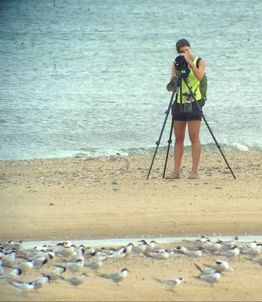 Melissa Althouse scans a flock of common terns and roseate terns
Melissa Althouse scans a flock of common terns and roseate terns
 Melissa Althouse scans a flock of common terns and roseate terns Melissa Althouse scans a flock of common terns and roseate terns Bird migration is one of the most spectacular phenomena in the animal kingdom, with some species traversing the distance from the Arctic to the Antarctic and back each year. Such a journey is energetically costly and physically demanding, and successful migration requires that birds be the best possible condition at the outset. High quality staging grounds (where some species flock up after the breeding season is over prior to migrating) and stopover areas (where some species flock up in the midst of a migratory journey to refuel) are essential for the survival of migration. Eastern Canada and the northeastern United States are home to an endangered population of roseate terns, which nest in mixed-species colonies on coastal islands and stage with their offspring primarily along Cape Cod, Massachusetts prior to migrating to the Carribean and South America directly over the Atlantic Ocean. Adult roseate terns catch small fish by plunging into the sea, and continue to bring food to their young during the staging period. At that time of year, they require quiet, undisturbed mudflats and beaches , where they can relocate their young and spend time resting and saving energy for the long journey to come. From late July through August, however, their preferred staging site at Cape Cod National Seashore is also one of the most popular destinations in the world for human beach recreation, leading to the continual potential for disturbance of roosting flocks that threatens their ability to store up the necessary energy for migration. A new paper in the Journal of Wildlife Management by Melissa Althouse reports the results of a human disturbance study to mixed-species flocks of common terns and roseate terns during the post-breeding staging period at Cape Cod, funded by the National Park Service. Melissa and her crew observed the interactions between tern flocks, human pedestrians, and other potential disturbance sources such as gulls, which steal fish from terns returning to their roosting areas, and shorebirds which are not a threat but do produce alarm calls that can rouse tern flocks. She recorded the distances at which approaching disturbance sources caused flocks to flush into the air, which uses up much-needed energy. Melissa found that human beachgoers at a distance of 100 meters from tern flocks led to about 4% of the flock flushing, which was about the same response observed to shorebird alarm calls when no humans were nearby. She also found that smaller tern flocks were more sensitive to human presence than large flocks. Based on these findings, managers can use signs and fencing to give terns space from human disturbance, during this critical time of year for energy conservation.
Comments are closed.
|
Categories
All
Archives
July 2019
|
 RSS Feed
RSS Feed
